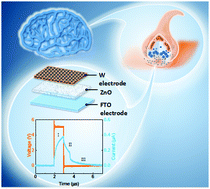Memristors mimicking the regulation of synaptic plasticity and the refractory period in the phenomenological model†
Abstract
Artificial electronic synapses must be developed for the effective implementation of artificial neural networks in machine learning. Memristors that mimic the functions of biological synapses have drawn enormous interest because of their potential applications in microelectronic chips. Herein, for the first time, a new function in the phenomenological model, namely the principle of refractory period function, is developed based on a W/ZnO/FTO memristor device. The two decay rates of the device obtained through applying a voltage pulse can faithfully emulate repolarization and hyperpolarization of the refractory action potential. Furthermore, by applying two different pulse trains, the absolute refractory period and the relative refractory period were also mimicked. High-resolution transmission electron microscopy observations clearly show that W diffuses into the ZnO film and forms a W-conductive protruding region between the W and FTO electrodes in the device in the “ON” state. The experimentally demonstrated refractory period function represents significant progress in the neuromorphic emulation of the functionalities of the biological synapse.



 Please wait while we load your content...
Please wait while we load your content...